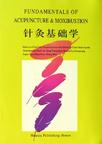针灸基础学
2006-8
华夏出版社
刘公望
370
618000
The first English edition of Fundamentals of Acupuncture & Moxibustion is based on the Japanese edition of this book, which was compiled by Liu Gongwang and Akira Hyodo and has been reprinted four times since its first publication in Tokyo, 1992.
In preparing the English manuscript of this book, Cao Qing translated Chapters One, Two, Four, Five and Sections I-II in Chapter Three. Guan Qisheng did the translation of Section III in Chapter Three, which was revised by Cao Qing. Liu Gongwang put Chapter Seven into English. Cao, Guan and Liu made joint efforts to translate Chapter Six into English. Wang Wei performed the manuscript typing and copying.
Liu Gongwang revised the whole English version from the viewpoints of TCM theories, clinical practice and experience of teaching western learners.
Cao, Guan and Liu had proofread all the pages of this book before it was printed.
Cao Qing contributed to the designs and readjustments of the patterns of the figures and takes in English of this book.
Zhang Yuqing compiled the indexes of this book and remade the figures, most of which originated from the Japanese edition, into English or easier ones for this English edition.
Preface to the Second EditionPrefaceChapter One Introduction to TCM SectionⅠBrief History of Acupuncture-Moxibustion A.Canon of Internal Medicine and Treatise on Febrile Siseases Caused by Cold B.Developments in Acupunxture-Moxibustion after the Han Dynasty C.Internationalixation of Acupunxture-Moxibustion SectionⅡ Fundamentals of TCM SectionⅢ TCM Philosophy and Its Methods of Study Timeline of Chinese HistoryChapter Two Basic Principles of TCM SectionⅠ The Outlook of the Organism as a Whole and the Adaptation of the Human Body to the Natural Environment A.Unity of a Human Body and the Nature 1.Influence of the Five Seasons and Climate on the Human Body 2.Diurnal Inrluences on the Human Body B.Human Body as an Organic Whole SectionⅡ Philosophy of TCM A.The Theory of Yin-Yang 1.Main Concepts of the Theoty of Yin-Yang 2.Application of the Theory of Yin-Yang B.The Theory of Five Elements 1.Main Concepts of the Theory of Five Elements 2.Application of the Theory of Five Elements to TCM SectionⅢ The Principle of Perpetual Motion:Ascending and Descending,Going Out and Coming In A.Explaining the Coordinated Functioning of the Internal Organs in a Physiological State B.Abnormal Ascending,dexcending,Going Out and Coming In of Qi in the Functioning of the Internal Organs C.Guiding the Establishment of Treatment Principles SectionⅣ The System Outlook——Slilction of Treatment based on Differentiation of Syndromes A.Differentiation of Patients B.Differentiation of Pathological Change Locatins C.Differentiation of disesase Causes D.Differentiation of Abnormal States E.Differentiation of PathogenesesChapter Three Morphology andFunction of TCM SectionⅠ The Theory of Qi,Blood and Body Fluid A.Qi 1.Classification and Formation of Qi 2.Functions of Qi 3.Movement of Qi B.Blood 1.Formation of Blood 2.Functions of Blood 3.Circulation of Blood C.Body Fluid 1.Formation,Distribution and Excretion of Body Fluid 2.Functions of Body Fluid 3.Classification of Body Fluid D.Relationships between Qi,Blood and Body Fluid 1.Relationship between Qi and Blood 2.Relationship between Qi and Body fluid 3.Relationship between Body Fluid and Blood SectionⅡ The Theory of the Internal Organs A.Introduction 1.Classification of the Internal Organs 2.Physiological Characteristics of the Internal Organs 3.Three Essential Factors in the Formation of the Theory of the Internal Organs 4.Major Characteristics of the Theory of the Internal Organs 5.Close Relationships between Human Mental Activities and Physiological Activties of the Five Zang Organs 6.Balance and Coordination among Physiological Functions of the Five Zang Organs 7.Comcepts of the Internal Organs in the Theory of the Internal Organs B.The Five Zang Organs 1.The Heart Appendix:The Pericardium 2.The Lung 3.The Spleen 4.The Liver 5.The Kidney C.The Six Fu Organs 1.The Gallbladder 2.the Stomach 3.The Small Intestine 4.The Large Intestine 5.The Urinary Bladder 6.The Sanjiao ……Chater Four Etiology and Pathlolgy of TCMChater Five Four Examination Diagnostic Methods in TCMChater Six Diagnosis and Treatment of TCM——Selection of Treatment based on Differentiation of SyndromesChater Seven Principles and Methods of TreatmentAppendix:Classics of TCMIndexⅠ Terms of TCM in English Alphabetical OrderIndexⅡ Terms of TCM in Chinese Alphabetical OrderIndexⅢ FiguresIndexⅣ Tables
